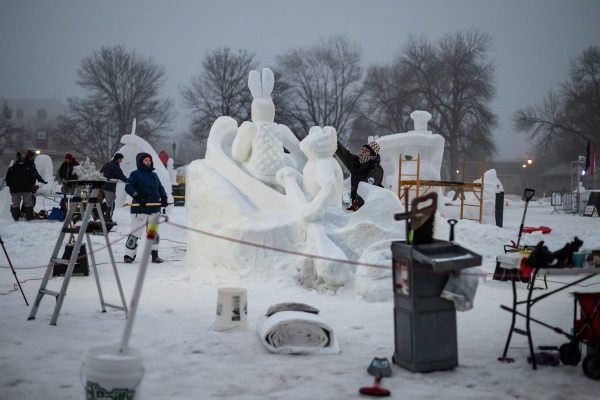Atlas Obscura is ringing in Native American Heritage Month with stories from across the country, from California to Wisconsin to Oklahoma. These Indigenous innovators are bringing back spirit horses, sculpting stories in snow, and finding other new ways to carry on old traditions.
by Roxanne Hoorn
In the early 1900s, Ojibwe ponies, also known as Lac La Croix ponies, numbered in the thousands. Bred by Indigenous communities throughout much of the Upper Midwest, the stout ponies spent their summers roaming nearby woods and, in the winter months, helped pull lumber and performed other tasks. Due to colonial persecution of the Ojibwe people and their ponies, by 1977, there were only four horses—all mares—left. Since then, the breed has slowly been reestablished, mostly on private residences in Canada. Now, White Earth Nation descendant Em Loerzel and her Anishinaabe community in western Wisconsin are helping the ponies make a comeback on their ancestral lands. Considered the Ojibwe people’s spirit horses, the repatriation of these animals is helping heal communities, too. “They are worth it when all else seems bleak—they are resilience personified,” says Loerzel.
by Sarah Lohman
The scent of roasting agave makes many people think of tequila, but for the Indigenous people of the Mojave Desert, it’s also an important seasonal food. The Cahuilla of Southern California have been gathering and roasting agave hearts for at least 3,000 years, if not since time immemorial, writes Sarah Lohman. Every April, the Malki Museum, the first nonprofit Native American museum on a California reservation, hosts an agave roast and native food tasting event that is open to the public. Agave is placed in pits, buried by sand and coals, and covered with metal sheets. After many hours of cooking, participants feast on tender roasted agave hearts, just as the Cahuilla people have for millennia.
by Fred Pearce
The Menominee Indian Reservation in northern Wisconsin is home to nearly a quarter-million acres of forest. Despite logging on the lands for more than a century, the area is home to more trees than ever. In almost 170 years, the tribe has harvested nearly twice the forest’s former volume of timber, yet it still has 40 percent more standing wood than when they started, writes Fred Pearce. Community foresters don’t plant new trees—instead, they give the forest time to regenerate naturally. “We make our decisions based on what’s best for the forest,” says veteran head forester Ron Waukau. “Our logging schedules and management are purely for the forest. I am really humbled to be able to work like that. The sawmill knows what it will get and sells accordingly.”
by Sarah Lohman
In the 1830s, the American government forced the Cherokee people to leave their homelands in the Southeast for Oklahoma. Roughly 17,000 Cherokee embarked on the long winter trek, carrying dried, dark beans in their pockets. Nearly 150 years later, dentist, circus owner, and gardener John Wyche gifted the seeds long protected by his ancestors to the Seed Savers Exchange, a nonprofit seed company. What does it say about the significance of these beans that in a time of great distress, they were saved, carried, and replanted? As Sarah Lohman asks, can our crops connect us from one homeland to our next?
In 2006, the Cherokee Nation founded their own seed bank to preserve the Trail of Tears beans and other culturally important crops. “It’s not just preserving seeds,” says Feather Smith, ethnobiology manager with the Secretary of Natural Resources Office for the Cherokee Nation, “it’s preserving our culture, our history, our way of life.”
by Roxanne Hoorn
On the edge of Wisconsin’s frozen Lake Geneva, this team of all Anishinaabe women turns a lump of snow into a work of art. They call their all-female group Team Kwe, after an Anishinaabemowin term for women. For 49 hours, they persevered through bitter cold, fought structural melt from rising daytime temperatures, and survived the delirium of sleep deprivation. In the end, their snow block took the form of an otter diving beneath lily pads, which they titled Ngig Nibi Ganawendan (Otter Water Protector), just one of many works inspired by their Anishinaabe roots. The sculptures aren’t just beautiful, but carry deep meaning for the “snow sisters” and their community. “Traditionally in the Ojibwe culture, storytelling season is when there’s snow on the ground,” says Heather Friedli, the most experienced snow sculptor on the team of three. “For us, telling a story is important.”


